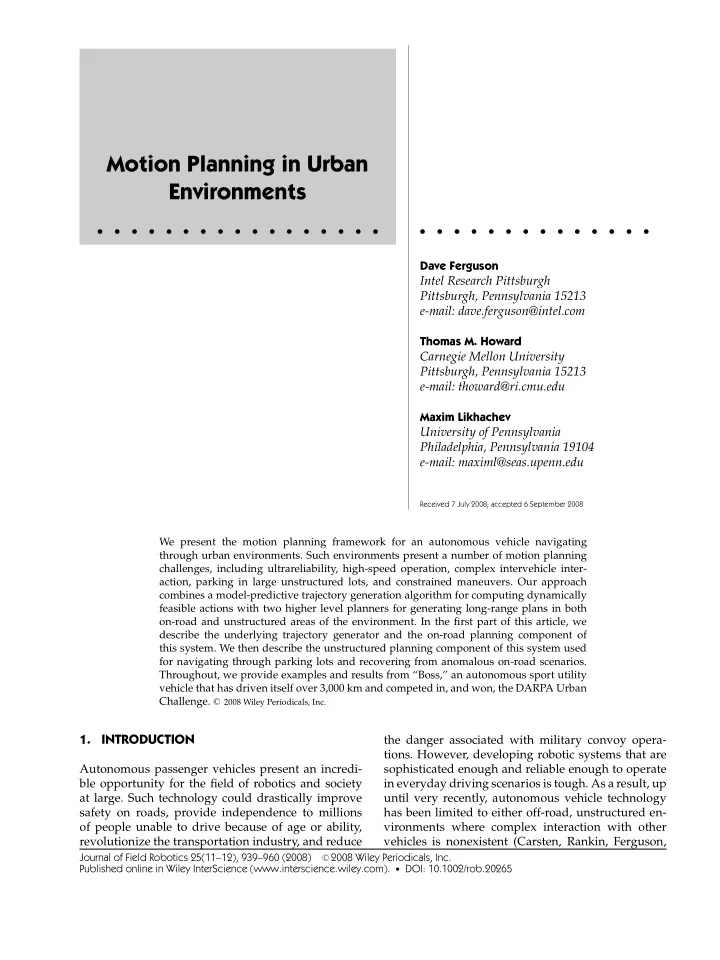

Motion Planning in Urban Environments • • • • • • • • • • • • • • • • • • • • • • • • • • • • • • • Dave Ferguson Intel Research Pittsburgh Pittsburgh, Pennsylvania 15213 e-mail: dave.ferguson@intel.com Thomas M. Howard Carnegie Mellon University Pittsburgh, Pennsylvania 15213 e-mail: thoward@ri.cmu.edu Maxim Likhachev University of Pennsylvania Philadelphia, Pennsylvania 19104 e-mail: maximl@seas.upenn.edu Received 7 July 2008; accepted 6 September 2008 We present the motion planning framework for an autonomous vehicle navigating through urban environments. Such environments present a number of motion planning challenges, including ultrareliability, high-speed operation, complex intervehicle inter- action, parking in large unstructured lots, and constrained maneuvers. Our approach combines a model-predictive trajectory generation algorithm for computing dynamically feasible actions with two higher level planners for generating long-range plans in both on-road and unstructured areas of the environment. In the first part of this article, we describe the underlying trajectory generator and the on-road planning component of this system. We then describe the unstructured planning component of this system used for navigating through parking lots and recovering from anomalous on-road scenarios. Throughout, we provide examples and results from “Boss,” an autonomous sport utility vehicle that has driven itself over 3,000 km and competed in, and won, the DARPA Urban Challenge. C ⃝ 2008 Wiley Periodicals, Inc. 1. INTRODUCTION the danger associated with military convoy opera- tions. However, developing robotic systems that are Autonomous passenger vehicles present an incredi- sophisticated enough and reliable enough to operate ble opportunity for the field of robotics and society in everyday driving scenarios is tough. As a result, up at large. Such technology could drastically improve until very recently, autonomous vehicle technology safety on roads, provide independence to millions has been limited to either off-road, unstructured en- of people unable to drive because of age or ability, vironments where complex interaction with other revolutionize the transportation industry, and reduce vehicles is nonexistent (Carsten, Rankin, Ferguson, ⃝ 2008 Wiley Periodicals, Inc. Journal of Field Robotics 25(11–12), 939–960 (2008) C Published online in Wiley InterScience (www.interscience.wiley.com). • DOI: 10.1002/rob.20265
940 • Journal of Field Robotics—2008 & Stentz, 2007; Iagremma & Buehler, 2006a, 2006b; motion planning framework used when navigating Kelly, 1995; Singh et al., 2000; Stentz & Hebert, 1995) on roads. or very simple on-road maneuvers such as highway- In Section 6, we discuss the framework used based lane following (Thorpe, Jochem, & Pomerleau, when navigating through unstructured areas or per- 1997). forming complex maneuvers. We then provide results The DARPA Urban Challenge competition was and discussion from hundreds of hours and thou- designed to extend this technology as far as possi- sands of miles of testing and describe related work ble toward the goal of unrestricted on-road driving. in both on-road and unstructured planning. The event consisted of an autonomous vehicle race through an urban environment containing single- 2. SYSTEM ARCHITECTURE and multilane roads, traffic circles and intersections, open areas and unpaved sections, road blockages, Boss’s software system is decomposed into four ma- and complex parking tasks. Successful vehicles had jor blocks (see Figure 1) and is described in detail to travel roughly 60 miles, all in the presence of in (Urmson et al., 2008). The perception component other human-driven and autonomous vehicles, and fuses and processes data from Boss’s sensors to pro- all while abiding by speed limits and California driv- vide key environmental information, including the ing rules. following: This challenge required significant advances over the state of the art in autonomous vehicle technol- • vehicle state , globally referenced position, ogy. In this paper, we describe the motion plan- attitude, and speed for Boss; ning system developed for Carnegie Mellon Univer- • road world model , globally referenced geo- sity’s winning entry in the Urban Challenge, “Boss.” metric information about the roads, parking This system enabled Boss to travel extremely quickly zones, and intersections in the world; through the urban environment to complete its mis- • moving obstacle set , an estimation of other sions; interact safely and intelligently with obstacles vehicles in the vicinity of Boss; and other vehicles on roads, at intersections, and in • static obstacle map , a two-dimensional (2D) parking lots; and perform sophisticated maneuvers grid representation of free, dangerous, and to solve complex parking tasks. lethal space in the world; and We first introduce very briefly the software ar- • road blockages , an estimation of clearly im- chitecture used by Boss and the role of motion plan- passable road sections. ning within that architecture. We then describe the trajectory generation algorithm used to generate ev- The mission planning component computes the ery move of the vehicle. In Section 5, we discuss the fastest route through the road network to reach the Figure 1. Boss: Carnegie Mellon’s winning entry in the Urban Challenge, along with its software system architecture. Journal of Field Robotics DOI 10.1002/rob
Recommend
More recommend